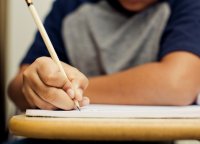Letter Writing as a Teaching Tool
A simple exercise helps students explore audience and argumentation.
Your content has been saved!
Go to My Saved Content.A letter allows the relationship between writer and audience to take shape in a personal, meaningful way. In high school English classes, students might overlook intended audiences in their analyses of texts. Students can read and compose letters as a way to grasp the complexity of a writer reaching a particular audience.
Imagining the Audience
When high school students approach text analysis, it can be difficult to imagine an audience other than themselves. Letters are approachable because they make somewhat transparent the relationship between writer and audience.
In a letter to her son, John Quincy Adams, former First Lady Abigail Adams provides a useful example of the relationship between writer and audience. In exploring this text with my classes, students benefited from considering how Adams’s complex relationship with her son might influence her purpose. She reminds him that much is expected of him as the son of an important American ambassador, writing, “It will be expected of you my son that as you are favour’d with superiour advantages under the instructive Eye of a tender parent, that your improvements should bear some proportion to your advantages.”
She is also an encouraging mother who writes to a reluctant son, “I know you capable of these exertions, with pleasure I observed my advice was not lost upon you.” Most contemporary high school students can relate to being on the receiving end of a loaded parental message of pressure and pride. The book Letters of the Century: America 1900–1999 offers a collection of similar historical letters.
Composing a Letter
Reading letters written by others helps students understand the relationship between the writer and the audience. Composing a letter can also allow students to understand the synergy between writer, audience, and purpose. Writing a letter of appreciation to a past teacher is one composition exercise to facilitate better understanding of writing purpose.
At my school, students write brief notes of appreciation a few times each year to teachers, counselors, and other school staff. Even these brief notes are surprisingly full of detail and consideration. Most recipients keep their notes, often displaying them for others to see. The task can be taken a step further when students share how their audiences responded and reflect on the impact of their message.
Framing Realistic Arguments
Argumentation related to a text offers yet another opportunity to practice writing for an audience. Discussion of a novel, such as To Kill a Mockingbird, requires that students articulate their reactions to topics that could be confusing or uncomfortable to address, like racial tension or sexuality. I ask my students to write postcards to each other to share their reactions. This exchange allows students to test their reactions with a single, informal, but specific audience. To keep the volley of a conversation going, they must consider their classmate’s reactions as well. Students will come to realize that they get the most out of the exercise when they go beyond surface-level reactions and make sure they have read the text ahead of time.
A more formal assessment of argument takes shape with a letter to the school board arguing for the removal or retention of the controversial text that has been studied. First, students read and analyze perspectives from three hypothetical school board members. Then they craft an argument responding to all three perspectives. The exercise requires sensitivity to the audience’s concerns.
When I first asked my students to respond to an initiative to ban our final book of the year, The Catcher in the Rye, I noticed that their responses were sometimes flippant, but with the addition of the school board perspectives, they were more cognizant of their audience. I encouraged them to directly address each stakeholder in their responses before launching into their overall arguments.
Using High-Tech Letters
Technologically savvy students may be receptive to writing a more modern letter: an email. After I coach them through goal-setting for various stages of argumentative writing, I introduce the expectation that we will exchange emails with updates about their weekly progress.
These emails may at first feel forced, but they eventually become an avenue to express authentic pride and frustration that accompanies their work. The variety of their responses is part of the beauty of this task. Last year, one of my students wrote a simple message describing his confusion about a topic, which prompted an almost immediate face-to-face conversation. Another student wrote a lengthy explanation of the moment when rhetorical analysis finally clicked for her.
If students prefer, I give the option that they may instead email “accountability buddies” who will hear them out and potentially offer suggestions.
As parent-teacher conference season rolls around, this email process can be used to communicate with parents. Students email their parents regarding their progress before parent-teacher conferences even begin, thus establishing student accountability. As they reflect on their progress and share their highs and lows, students take ownership over their learning. Parents sometimes add messages of pride and encouragement to the email chain.
Exploring the facets of letters as forms of writing should be an opportunity for both practical knowledge and artistic experimentation with argumentative writing. Perhaps it should not be surprising that the complex relationship between writer, audience, and purpose seems most accessible in the direct and incredibly personal act of letter writing.
